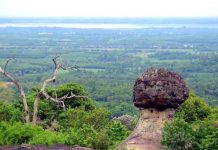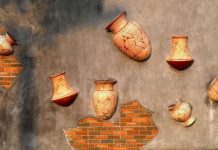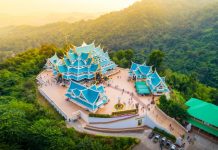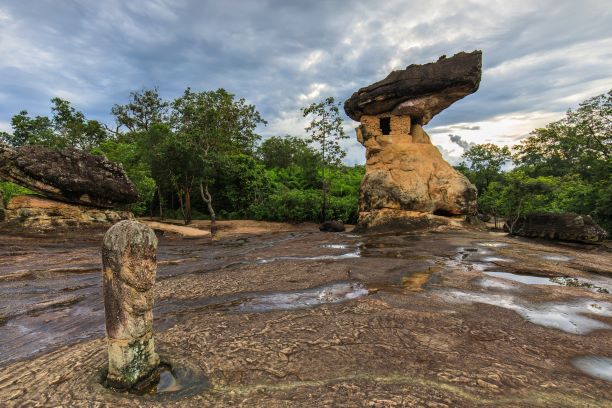
Phu Phra Bat Historical park, the beauty of the nature & the land of the folk legend of Udon Thani
Udon Thani is another province of the upper Isan or northeast of Thailand where the location is rich of the tourist attractions. Especially, the remarkable sightseeing ‘Phu Phra Bat‘ that is such a fantastic site leading the government proposed it to be one of the world heritage. Besides the wonderful landscape, the place with natural decorated with the unusual rock formations and the mythology behind them might be the right destination for those who seek for something a bit of mystery with the beautiful nature.
About the place
Literally called “Phu Phra Bat Historical Park”, the site situates on ‘Phu Phra Bat’ a small mountain of the Phu Phan Range which is the western rim of the Sakon Nakhon Basin occupies the area of Mueang Phan and Klang Yai sub-district in Ban Phue district, Udon Thani (about 12 km from the Ban Phue town to the west). The mount is between 320 – 350 meters high above the sea level with approximately 5.488. sq.km of space which is a national forest park ‘Pa Khua Nam’. The area is mixed of diverse forest including deciduous dipterocarp forest, mixed forest, and dry evergreen forest resulted in it is a vital source of water with abundant and varied species of plants; flower, perennial plant, and herbs. Also, the essential food and natural resource supplier for the local since the previous times.
“Phu Phra Bat” the name of the place derived from the Buddha’s footprint enshrined on this mountain, additionally there are numerous of the bizarre rock formations spread over the area of the historic park. These rocks formations are sandstone categorized in the Phu Phan formation reassigned to the Early Cretaceous or around 130 million years ago created by the natural erosion of water and wind for the millions of years. As a result, geographical features turned to the unusual rock formations – column and rock shelter as we can see nowadays.
Within the terrain of Phu Phra Bat Historical Park, further from the natural resource the trace of the prehistorical life also founded at the location. The evidence of the prehistorical civilization was discovered and initially proclaimed as a historic site recorded in the government gazette, volume 52, chapter 75 dated March 8,1935 by Office of the Royal Society with the title was “Phra Phutthabat Bua Bok” at Muaeng Phan, Ban Phue district. After that, the observation and publishing about the place had increased until the year 1992 the Department of Fine Arts arranged to set up “Phu Phra Bat Historical Park” office to respond to all pieces of the ancient ruins and the archaeological finds within the venue. The historic site was opened officially on June 26, 1992, and the Princess Maha Chakri Sirindhorn graciously presided over the ceremony.
The Geographical Characteristic
Phu Phra Bat is different forms of rock and shelter scattering around the area of the mountain which resulted from the erosion of the sandstone with different hardness in each layer of the stone of which the real sandstone that is very firm and the layer with mixed sandstone and lime that less in its firmness. For countless of the time, the formation of the rock in many bizarre shapes showing the visitors to see the miracle of nature. Over 2,000 – 3,000 years ago, the human lived the life by hunter-gatherer and while they were staying the night over the cliff which is the excellent shed of nature they did many drawings – people, animals, hands, included any symbolic graphics over the stone wall. And these paintings have displayed within the area of Phu Phra Bat Historical Park, for example at Tham Wua, Tham Khon, and the color painting at Noan Sao Ae. And those of the historical pictures have carried on to be the puzzle for the new generation to find out the story behind them from then on.
The interesting historical sites at Phu Phra Bat
1. Ho Nang U-sa
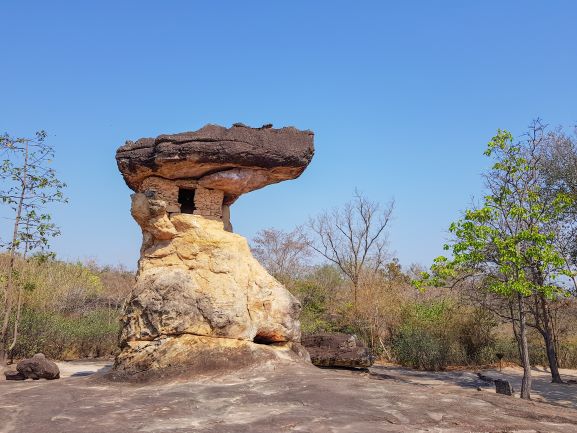
The stone is so-called the signature of Phu Phra Bat Historical Park. The outstanding rock formation is a large stone shed created by nature with about 10 meters high estimate. The mushroom-like rock formation stands elegantly in the center of the spacious ground that highlights itself to be distinguished from other ancient monuments at the site. Illustrating in the archeological evidence assumed that this unusual rock formation is able to track back to the Dvaravati era or around the 12th -16th Buddhist Centuries. The structure was applied to be the Buddhist site to organize any religious rituals. The sandstone blocks were assembled to be the wall at the upper structure and chiseled the shale inside to be the cavern which presumed that it might be whether the place to store the sacred objects or the altar.
2. Phra Phutthabat (The Buddha’s Footprint)
– Phra Phutthabat Bua Bok
The figure situated within the compound of Wat Phra Phutthabat Bua Bok. Initially, it was an engraved rilievo on the natural rock ground, and then it was covered with the replica of the Buddha’s footprint inside the lotus bud-shaped pagoda.
– Phra Phutthabat Lang Tao
Located in the south of Phra Phutthabat Bua Bok, this Buddha’s footprint is a craved in the stone. In the middle of the print is the lotus image with a great shape of the petals allowing us to see apparently. And since the location of this holy image is close to the turtle-shaped rock formation resulted in it named as Phra Phutthabat Lang Tao (Lang Tao means turtle’s back).
– Phra Phutthabat Bua Bat
Situated on the hill in Muaeng Phan sub-district. Apart from the replica of the Buddha’s footprint the venue also has the numbers of sandstone Sema (the marker stones) with the figure of the person in Dvaravati art, as well.
3. Tham Phra (The Monk Cave)
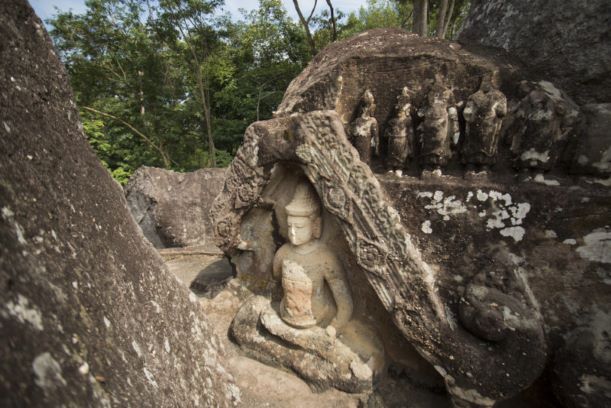
This ancient site is a low and narrow rock shed that was modified to be the Buddhist temple as seen in the wall underneath the shed that engraved with the Buddha images all around, including the large size of Buddha image in the attitude of meditation sitting inside the gable arch. Moreover, the 6 pictures of the small standing Buddha, and other Buddha images in various postures. The scholars noted that these Buddha images present the mixture of Dvaravati and Khmer (or Lopburi) art leading to the assumption that this holy place might be in the late of Dvaravati to Lopburi era or around the 16th – 18th Buddha Centuries when the time of the glory of the Khmer Kingdom that its culture and art expanded into the Thai region.
Unfortunately, the rock at the top of the structure which was the shelter fell down caused to lots of the stone sculptures inside the cave were ruined and some damaged by the wrongful livelihood.
4. Gu Nang U-sa (U-sa Stupa)
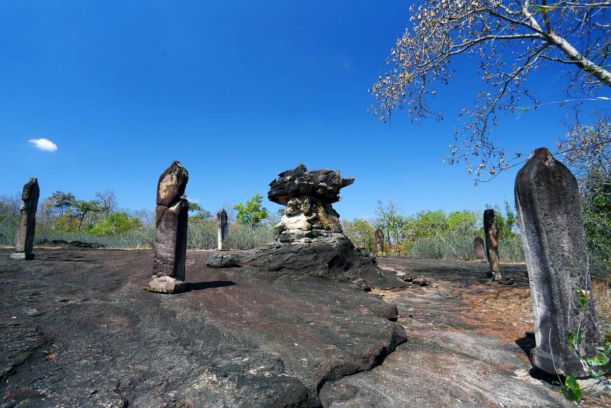
Or also called “Gi Nang U-sa”. The reason to call this structure into 2 names since the mythology of “Princess U-sa and Lord Barot” was told in many literary styles, some called ‘Gu Nang U-sa’ which means the stupa to store the ashes of Princess U-sa. On the other hand, some called “Gi Nang U-sa” which means Princess U-sa’s loom.
This ancient remain is natural rock formation with about 3 meters wide, 3 meters long, and 4 meters in its height. And the pieces of archeological evidence showed that they can be categorized into two periods which are the prehistorical evidence of the color painting in the west. Moreover, the historical evidence that is the pit under the rock which might be the place to enshrine the holy object or the Buddha image and Sema, the markers stones situated in all 8 directions of the Buddhist holy place. Also, the foundation of the rounded columns lined in the square around the Sema that possibly is the defensive wall pillar.
It assumed that the place might be the venue to set up the Sangha ritual or the place to enshrine the holy object with age around the Dvaravati period.
5. Wat Look Kheoi (The Son-in-law Temple)
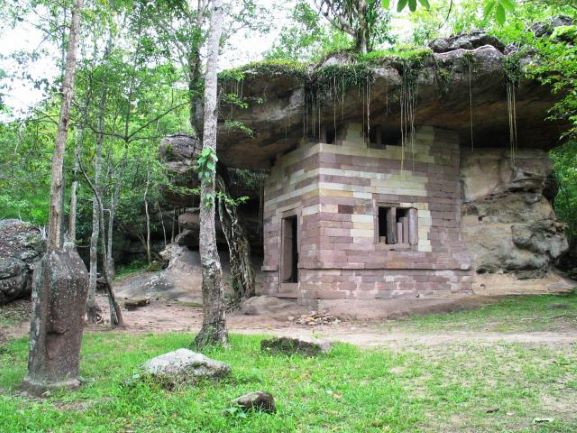
It stands in the northeast of Wat Pho Ta about 100 meters. The structure is a natural rock that was applied to use as the temple as same as the ordination hall presently. The many blocks of the squared sandstone assembled to the wall and the frame of door and window with the entrance in the north, and the 3 figures of Sema are outside. However, the current condition of the structure is the renovated version. It assumed that this sacred place might be constructed when the local craftsmen learned how to use rock in the construction as same as the building of the rock castle. That means it was the time after the ancient Khmer influenced the area of Phu Phra Bat in the 16th – 19th Buddhist Centuries, estimate.
6. Wat Pho Ta (The Father-in-law Temple)
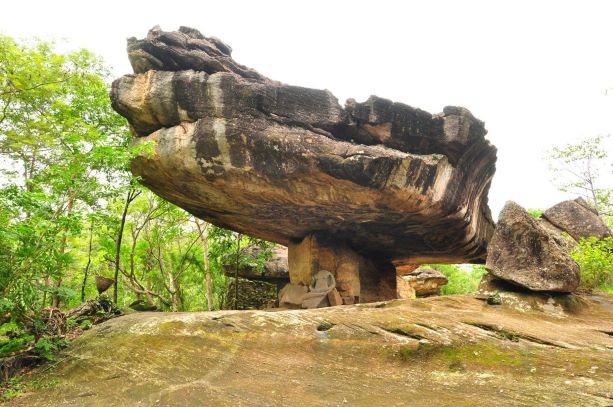
It is a large rock formation with about 2.9 in its height with the flat and slim shaft to support the large roof above. The space underneath the shelter was polished to usable with many rounded patterns in red on the southeast wall. Each circle leaves the area in the middle that shaped like the Buddha image caused to the assumption that this place used to be the holy site with a large number of the Buddha images stored next to the wall. Also, the red pattern on the wall could be the radius or the background of the statues followed to the purpose of the creator.
The wall in all directions present the part of the Buddha images and pieces of the sculpture, and some of those were transferred from Tham Phra that hard to identify which one originally belongs to Wat Pho Ta, though. Nonetheless, the scholar noted that these Buddha images are Dvaravati art by the local artist that can be noticed from the relaxed meditation posture and the proportion of the hands and feet that are irregular large.
7. The Stone Ground in front of Wat Pho Ta
It is an open-space ground among Tham Phra, Wat Pho Ta, Lord Barot’s Coffin, and Pho Ta’s Coffin. There are the marker stones installed around the area with the shallow squared basin inside the boundary. Also, the exterior is 67 pits with about 5 – 10 cm of diameter. It assumed that the ground used to be the venue to pay homage to the Buddhist monks who practiced at Phu Phra Bat which was the same period of Tham Phra and Wat Pho Ta.
8. Pho Ta’s Coffin (The Father-in-law’s Coffin)
This ancient ruin is 5 x 6 meters and approximately 5 meters high which also called in another name as “Tham Mue Daeng” (means the red hand cave). It is a natural rock formation that discovered the archeological evidence which is the prehistorical painting and the engraving work of the stone under the shed. So, it assumed that this coffin might be used since the prehistoric time until the old age.
9. Tham Wua (the Cow Cave) and Tham Khon (the Man Cave)
Based on the legend of Princess U-sa and Lord Barot, some literature styles describe the image of the seven people on the cave wall might be the princes that the lady-in-wait drew for the princess for the mate selection.
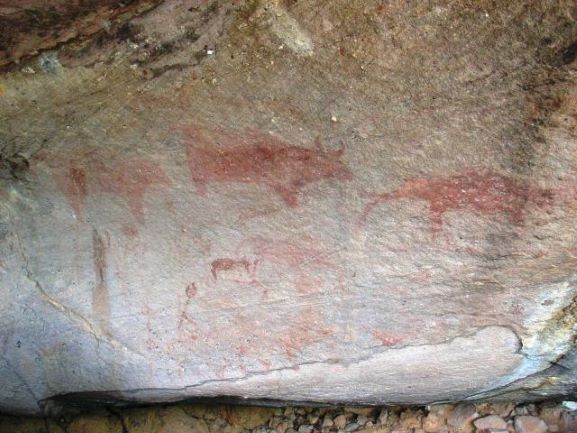
Tham Wua and Tham Khon are the ancient remains that shared the shelter as a home of the notable prehistorical cave painting of Phu Phra Bat Historical Park. The 1.5 x 4 meters stone formation is a large overhanging rock which can protect from rain and sun. The paintings are divided into 2 sides which are the group of cow painting in the east and the group of men painting in the north. The images are decorated with the red and white gradient which the latter is both original and one added later.

The part of Tham Khon is the image of seven people stand to the east in bold red color with quite clear details – bloating calf of legs that implied to the people in the picture could be ones who used legs a lot, completed fingers, everyone shows the movement. Also, the details of the gender like the sexual organ of the man, the picture of the person with long hair that might be referred to the woman, and two more color paintings on the ceiling in the west in red and white color.
While at Tham Wua, the paintings were drawn in red but they are very faded. The pictures divided into 2 sides. The left part is the image of two animals turn the face to the south, the former looks like chevrotain, but the latter can identify only that it’s a four-footed animal with a long tail and hornless. And the right side is the picture of a group of cows turn the head to opposite side from the first row. Next, it is a picture of three cows with hump are walking in line, and lower is a line figure of the twig mixed together with the image of calf and cow and other three unidentified animals (the most right one looks like it’s not completed).
10. Kork Ma Noi (The Pony’s Stable)
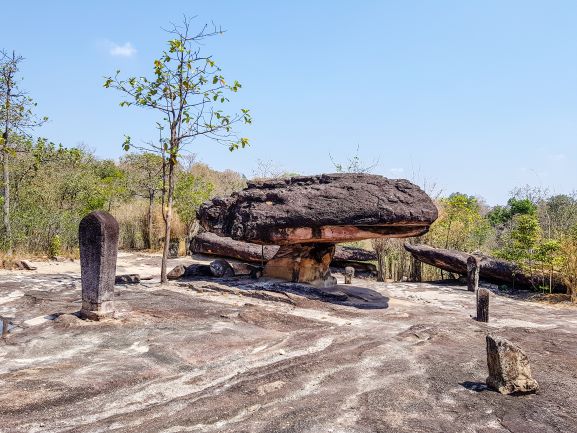
This ancient remain is a small rock formation with a large piece of stone as a shelter, but the wall is tiny and narrow. The space underneath the shed was craved to be the flat floor that might be used for meditation practice or enshrine the holy objects. Around the structure are the boundary stone markers in eight directions that installed within the squared frame. It assumed that this archeological site was a Buddhist holy site in the Dvaravati period.
Currently, the Sema (the stone markers) is only 6 left while the other 2 are just the foundation. The six stones are plain without any pattern. 2 pieces are the most perfect and largest ones which are the lotus petal shaped stone located in the west and southeast of the ruin.
11. Noan Sao Ae
A group of historical sites where the place is another home of the color painting within the Phu Phra Bat Historical Park. The location is about 300 meters from Phra Phutthabat Bua Bok to the southwest features the massive sandstone formation with approximately 10 meters wide, 11 meters long, and 5 meters in its height. The name of the site ‘Noan Sao Ae’ is based on the belief that this location was the cloth changing area before go to pay homage to the Buddha’s footprint.
There is the archeological evidence founded at the site which is two different period color paintings by following;
- The prehistorical painting colored in red. The series of paintings are paralleled pattern, sawtooth-formation, spiral, coconut-leaf stalk, long run-on squared shape, stripes, chain-shaped, triangle, curvy lines, stepped lines, and parallel lines.
- The historical painting colored in white with the figures of animals such as elephant, swan, and horse and other patterns that were scattered around interrupted. Also, the pictures of the swan, horse, and many designs that covered with the red paintings that expected it might be the historical evidence in the present days.
12. Tham Rue Si (The Hermit Cave)

About 50 – 60 meters from Tham Wau – Tham Khon to the south is a historic site features the gigantic rock formation with more than 10 meters in its height. The mushroom-like structure with the boundary stone markers installed around the cave inside the squared line. The existing Sema is only 7 of which the 8 directions and the north marker is the missing one. Those of seven Sema that all faced to the ancient remain have no any pattern which is in both plated and squared shape with the lotus petal shape on the top in most of them. However, the stone markers are quite perfect in condition. It surmised that this cave was modified from the natural rock shed to be the venue to set the Buddhist religious activities for the monks in Dvaravati era.
Tourist Information
Phu Phra Bat Historical Park opens every day between 8.30am – 4.30pm. The site provides the facilities for the visitors including, Information Center, Conference Hall, Library, Accommodation, Restrooms, Snack Shop, Souvenir shop, and Electronic Four-wheel shuttle. The admission fee is THB20 for Thai and THB100 for the foreigners.
For any further inquiries or visit the location or the workshop at Phu Phra Bat Historical Park, the tourist can contact at the historical park office +6642-219837, +6642-219838. Moreover, Phu Phra Bat services the shuttle vehicle with free of charge for the disability and anyone who needs special care. Also, the park offers the touring guide to give you the details of the archeological site without any fee, as well.
How to get to Phu Phra Bat Historica Park
The historic park is about 67 km from Udon Thani town on highway number 2 (Udon Thani – Nong Khai). When you arrive at the 13th km then turns left to enter the road number 2021 to Ban Phue district. Then, you keep driving about 42 km and turns right and continue about 500 meters. So, you stay on the highway number 2348 in about more 12 km and then make the right fork and drives 2 more kilometers to the destination.

